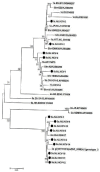The Investigation of Drug Resistance Substitutions in NS3 Protease Sequence of Hepatitis C Virus from Non-Responder Patients
- PMID: 31450900
- PMCID: PMC6852801
- DOI: 10.31557/APJCP.2019.20.8.2311
The Investigation of Drug Resistance Substitutions in NS3 Protease Sequence of Hepatitis C Virus from Non-Responder Patients
Abstract
Background: Even with the fantastic successes of direct-acting antivirals (DAA) in the treatment of Hepatitis C Virus (HCV) infection, natural drug resistance remains a challenging obstacle for their impacts. The data regarding protease inhibitors (PIs) resistance in Iran population are limited. The aim of this study was to investigate the variations in NS3 protease of HCV from non-responder patients. Methods: In this cross-sectional study, 14 HCV infected patients with genotype 1(N=5) and 3(N=9) who have not responded to Interferon-related regime were enrolled from Liver Clinic, Shiraz. The NS3 protease region was amplified by Nested-PCR followed by product gel extraction. Besides, some amplified protease regions were cloned into a cloning vector to improve the sensitivity of mutation detection. Both crude and cloned sequences were then introduced into sequencing. The obtained sequences were compared with the NS3 reference sequences and analyzed by Geno2pheno available software to find possible substitutions. In the end, the phylogenetic tree was constructed. Results: Among variations responsible for PIs resistance, only one out of 14 (7%) sample who was infected with genotype 1a, harbored R117C+N174S double mutation, which causes reduced susceptibility to Telaprevir. Any another resistance mutation was not found among the studied population. The most frequent substitutions were determined as I52M(N=9), S102A(N=9), S166A(8) and V170I(8) for genotype 3a, and F147S/A(4) for genotype 1. However, some uncharacterized substitutions on scored position, including I132L(N=1), I170V(N=3) and N174S(N=2) were also determined among sequences. Phylogenetic analysis demonstrated that the protease region has enough power to correctly classify enrolled samples into relevant clusters on the tree. There were 2, 3 and 9 cases of sub-genotypes 1a, 1b, and 3a, respectively. Conclusion: A low frequency of PIs resistance mutations in our HCV infected population is a hopeful point of starting these drugs in HCV infected patients.
Keywords: Drug resistance; Hepatitis C Virus; NS3; phylogenetic analysis; protease inhibitors.
Conflict of interest statement
All the authors declared no conflict of interest.
Figures



Similar articles
-
[Determination of drug resistance mutations of NS3 inhibitors in chronic hepatitis C patients infected with genotype 1].Mikrobiyol Bul. 2017 Apr;51(2):145-155. doi: 10.5578/mb.53824. Mikrobiyol Bul. 2017. PMID: 28566078 Turkish.
-
Implications of baseline polymorphisms for potential resistance to NS3 protease inhibitors in Hepatitis C virus genotypes 1a, 2b and 3a.Antiviral Res. 2013 Jul;99(1):12-7. doi: 10.1016/j.antiviral.2013.04.018. Epub 2013 May 3. Antiviral Res. 2013. PMID: 23648709
-
Prevalence of hepatitis C virus variants resistant to NS3 protease inhibitors or the NS5A inhibitor (BMS-790052) in hepatitis patients with genotype 1b.J Clin Virol. 2012 Aug;54(4):352-4. doi: 10.1016/j.jcv.2012.04.024. Epub 2012 Jun 1. J Clin Virol. 2012. PMID: 22658798
-
NS3 protease polymorphisms and genetic barrier to drug resistance of distinct hepatitis C virus genotypes from worldwide treatment-naïve subjects.J Viral Hepat. 2016 Nov;23(11):840-849. doi: 10.1111/jvh.12503. Epub 2016 Jan 18. J Viral Hepat. 2016. PMID: 26775769 Review.
-
Hepatitis C virus resistance to protease inhibitors.J Hepatol. 2011 Jul;55(1):192-206. doi: 10.1016/j.jhep.2011.01.011. Epub 2011 Feb 1. J Hepatol. 2011. PMID: 21284949 Review.
Cited by
-
Molecular Mechanisms of Resistance to Direct-Acting Antiviral (DAA) Drugs for the Treatment of Hepatitis C Virus Infections.Diagnostics (Basel). 2023 Sep 30;13(19):3102. doi: 10.3390/diagnostics13193102. Diagnostics (Basel). 2023. PMID: 37835845 Free PMC article.
-
Hepatitis C Viral Replication Complex.Viruses. 2021 Mar 22;13(3):520. doi: 10.3390/v13030520. Viruses. 2021. PMID: 33809897 Free PMC article. Review.
References
-
- Bartels DJ, Zhou Y, Zhang EZ, et al. Natural prevalence of hepatitis C virus variants with decreased sensitivity to NS3• 4A protease inhibitors in treatment-naive subjects. J Infect Dis. 2008;198:800–7. - PubMed
-
- Courcambeck J, Bouzidi M, Perbost R, et al. Resistance of hepatitis C virus to NS3-4A protease inhibitors: mechanisms of drug resistance induced by R155Q, A156T, D168A and D168V mutations. Antivir Ther. 2006;11:847–55. - PubMed
-
- Dehghani-Dehej F, Sarvari J, Esghaei M, et al. Presence of different Hepatitis C virus genotypes in plasma and peripheral blood mononuclear cell samples of Iranian patients with HIV infection. J Med Virol. 2017;90:1343–51. - PubMed
MeSH terms
Substances
LinkOut - more resources
Full Text Sources
Medical

